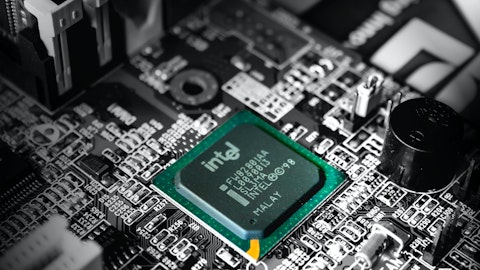Vedvati Shrotre: Thank you. And I have one more but I’ll get back into the queue.
Operator: We’ll take our next question from the line of David Duley with Steelhead. Please go ahead.
David Duley: Yes, thanks for letting me ask a question. If we could just kind of dig in on lithography issue. You know, you’ve had systems push out for two quarters in a row, I guess, if my recollection is correct. And is this more of the — just kind of go into? You mentioned it’s your internal production issue is? Or is it the tools performance? Or is the customer’s not ready for it? Could you just elaborate in greater detail about why are we seeing these pushes?
Michael Plisinski: Yes, that’s a good — it’s a good question. So it’s been a mix. As you know, in Q2 the issue was tied more towards the customers making some changes that we had to adapt to and weren’t able to complete all of the work required. But as we move those tools into the next quarter, we were unable — which would be this quarter, we were unable to deliver what we had already committed for the quarter plus pick up some of this extra work — these tools are large, they take up base in the factory, delays actually have a pretty big impact. The other — I think the other thing to understand is, in these systems we have about 3,200 out of 17,000 parts; the major parts, not screws and nuts and bolts, but 17,000 major parts to make a litho tool.
Out of that around 3,200 our custom engineered parts by the team here. And to give you an idea, in our most advanced metrology system, there’s only about 100 custom engineered parts. So the level of complexity of the systems and the manufacturing flows, and the calibration times, the integration times, it’s just taking more effort to drive the discipline and the processes to make these systems more predictable given that complexity. That said, because we do a lot of the custom engineering ourselves, we’ve been able to drive improvements in the system fairly significantly. So on the first four systems, since the first four systems we delivered, we’ve improved cycle times by 40%, we’ve doubled the capability of our overlay, I think we’ve improved throughput something like 30% or 20%.
So it’s there’s definitely a trade-off, there’s a benefit of having the highly engineered system but the cost is the complexity in manufacturing.
David Duley: And how — you know, so essentially, you can’t basically take the systems that slipped last quarter into this quarter and build. Basically we have to build twice as many. How do you fix this problem? When will that problem be fixed? Obviously, you need more internal capacity. So is that why it doesn’t get better till the middle of April or whenever?
Michael Plisinski: Yes, exactly. It’s — we need to finish some of these processes, we need to get our supply chains to be more responsive, we’ve had a lot of issues with incoming quality that that also require then rework and take too much time and too much base space. So we can’t move these systems. So as we work through all this, and again, we’re making steady progress is just not fast enough. It’s no fun for me to keep guiding and then updating the guidance or missing the guidance. So we’re resetting, giving the time team to get more predictable, and I expect, you know, middle of next year, so by the second quarter, we will be able to reach our full capacity, which is you know, significantly more than $80 million.
David Duley: And so let’s just boil that down to so you’re going to go from three tools a quarter to be able to produce six tools a quarter, because that seems like what your problem is now.
Michael Plisinski: Yes, that’s, that’s fair.
David Duley: Okay. All right. One final one for me. Thank you very much for that clarification that was appreciated. You mentioned you know, the TAM for your films tool will grow by 30% as we move the gate all around, and I’ve seen backside powers in that calculation too. Could you just help us understand what the PAM is and you know also help us understand what you’re kind of what that means for how much revenue that would be for Onto?



